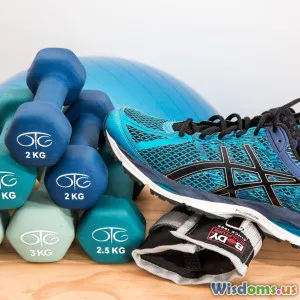
Seven Surprising Benefits of Resistance Bands for Home Training
8 min read Discover seven unexpected advantages of using resistance bands for effective home workouts, boosting strength, flexibility, and overall fitness. (0 Reviews)
Seven Surprising Benefits of Resistance Bands for Home Training
Home workouts have surged in popularity, and resistance bands have become one of the most favored tools for fitness enthusiasts. Often underestimated, these simple elastic bands offer a surprising array of benefits that extend far beyond basic strength training. This article dives deep into seven unexpected advantages of resistance bands for home training, showcasing their versatility, efficacy, and convenience. If you’re looking to enhance your exercise routine or seeking a new way to stay fit at home, read on to uncover why resistance bands deserve a spot in your workout arsenal.
1. Enhanced Muscle Activation and Strength Gains
Unlike free weights that rely on gravity, resistance bands provide variable resistance through the entire range of motion. This leads to increased muscle activation, especially in stabilizer muscles.
A 2017 study published in the Journal of Physical Therapy Science demonstrated that resistance bands resulted in comparable or even higher muscle engagement compared to traditional weight machines.
For example, during a squat using bands, the resistance increases as you ascend, challenging muscles differently than a barbell squat. This constant tension helps stimulate muscle fibers more thoroughly, promoting enhanced strength and power development.
Training with bands can also complement weightlifting routines, preventing plateaus by adding fresh resistance patterns and angles.
2. Improved Joint Health and Mobility
Resistance bands are exceptionally gentle on joints due to their elastic nature, making them ideal for people with arthritis or joint pain. They allow controlled movement which reduces impact stress.
Physical therapists often use bands for rehabilitation because they help restore strength while improving mobility. A physical therapy guide from the American College of Sports Medicine highlights band exercises as effective for regaining range of motion post-injury.
For instance, shoulder abduction with a band not only strengthens the deltoid but also facilitates smooth joint movement without strain.
Regular band training encourages joint stability, reducing risks of injury by strengthening supporting tendons and ligaments.
3. Compact and Cost-Effective Fitness Solution
Resistance bands are a perfect option for space-conscious individuals. Unlike large machines or sets of heavy dumbbells, bands are lightweight, portable, and easy to store.
Their affordability is another huge draw. High-quality resistance bands typically range from $15 to $40—a fraction of the cost of conventional gym equipment.
This accessibility enables people worldwide, even with limited resources, to engage in strength and conditioning programs effectively.
A New York Times article highlighted a surge in home band exercises during the pandemic, praising their convenience and adaptability.
4. Versatility for Full-Body Workouts
One band, multiple workouts! Resistance bands can target virtually every major muscle group. From biceps curls and chest presses to glute bridges and lateral walks, the possibilities are vast.
They accommodate varying fitness levels due to bands’ different resistance grades, from light to heavy. Beginners might start with lighter bands for rehabilitation or endurance, while seasoned athletes can challenge themselves with heavier resistance.
Here’s a sample full-body routine achievable with just resistance bands:
- Upper Body: Band pull-aparts, overhead press
- Core: Russian twists with band, plank rows
- Lower Body: Squat to side step, kickbacks
This adaptability confirms bands as a one-stop tool for well-rounded fitness programs.
5. Aid in Injury Prevention and Recovery
Resistance bands support muscular balance and correct movement patterns, crucial for injury prevention. They improve proprioception—the body’s sense of position—which helps maintain stability during dynamic activities.
Athletes frequently employ bands during warm-ups to activate muscles and prevent strains. For example, NFL teams use bands for pre-game activation exercises that lessen injury risks.
Post-injury, bands enable low-impact strengthening that minimizes joint load yet rebuilds functional strength.
Jessica Matthews, a certified physiotherapist, states, “Resistance bands are invaluable both for prehab and rehab; they increase strength without compromising safety.”
6. Improved Coordination and Balance
Training with resistance bands challenges neuromuscular coordination because maintaining tension requires conscious control. This enhances motor control, which translates to better balance and fluidity in daily movements.
Research published in Frontiers in Physiology (2020) showed that resistance band exercises improved balance metrics significantly in older adults, lowering fall risk.
Balance and coordination training with bands benefits athletes, seniors, and anyone seeking improved functional fitness.
An example is standing on one leg while performing band rows, which engages core stabilizers and sharpens body awareness.
7. Customization and Progressive Overload Made Simple
Progression is key to fitness gains, and bands make it easy. You can increase difficulty by:
- Using thicker or multiple bands
- Increasing range or tempo
- Changing angles to target muscles differently
This means workouts remain challenging regardless of your fitness journey stage.
Custom routines can be crafted for rehabilitation, fat loss, strength building, or athletic performance.
A fitness expert, Mike Simone, notes, “Bands give trainees the ability to adjust resistance on the fly, making them incredibly flexible for programming.”
Conclusion
Resistance bands offer a multifaceted tool for your home fitness regimen. Beyond their portability and budget-friendly nature, they enhance strength, joint health, mobility, coordination, injury resilience, and enable fully customizable workouts.
Whether you are recovering from injury, striving for peak athletic performance, or simply seeking an effective home workout, resistance bands can be the surprising game-changer you need.
By incorporating resistance bands with intention and knowledge, you pave the way for stronger muscles, healthier joints, and long-lasting fitness gains—all from the comfort of home.
Why not grab a set and experience these benefits firsthand?
References and Further Reading
- Journal of Physical Therapy Science, 2017: Muscle Activation with Resistance Bands
- American College of Sports Medicine: "Resistance Bands in Physical Therapy"
- New York Times, "How Resistance Bands Took Over Home Workouts"
- Frontiers in Physiology, 2020: Balance Improvements with Bands
- Personal communications with Jessica Matthews, Physio
- Expert insights from Mike Simone, Certified Trainer
Embrace the stretchy revolution and unlock the full potential of resistance band training in your home fitness journey.
Rate the Post
User Reviews
Popular Posts
















